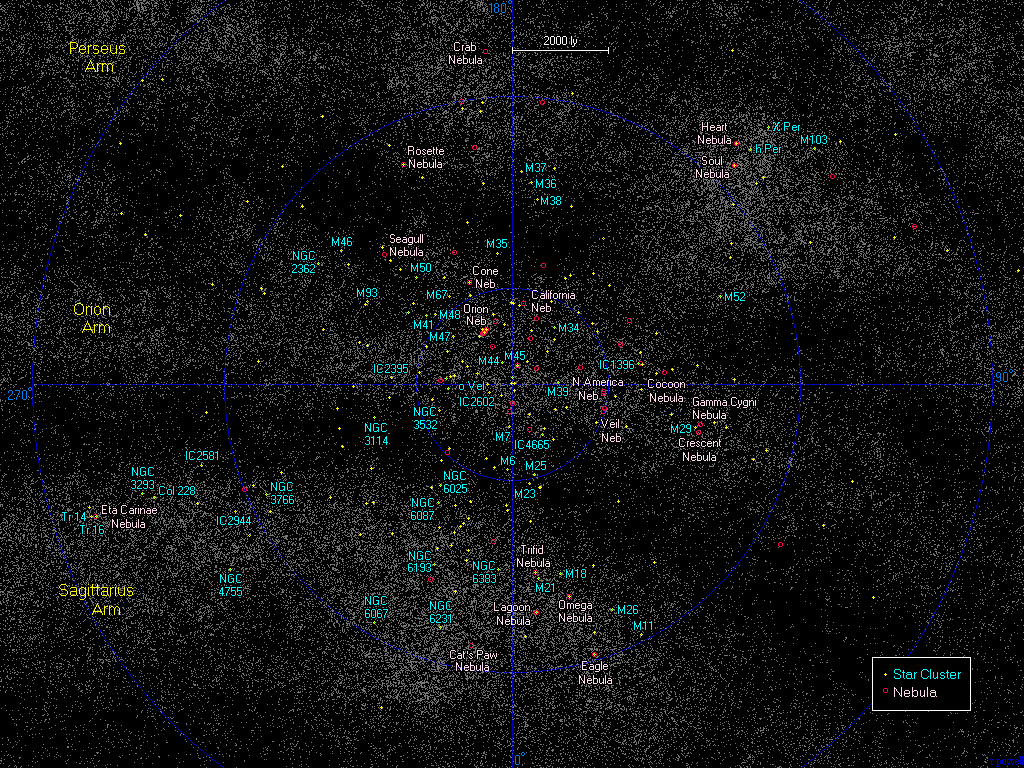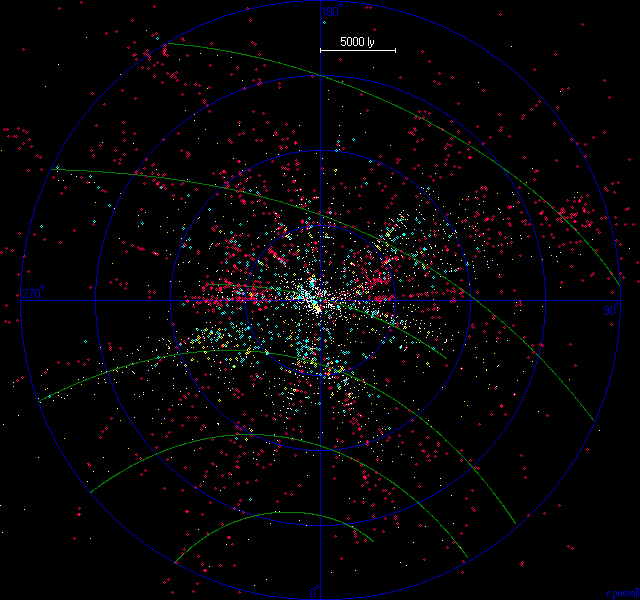
This is a map of the major star clusters and nebulae within 10000 light years. The map is orientated so that we are looking straight down at the galactic plane with the Sun at the centre of the map. Nearly all of the most famous star clusters and nebulae are labeled on the map. Because of all the intervening dust and gas lying in the galaxy it is very hard to see much beyond this distance in the galactic plane.

Below is a map which attempts to show the nearest part of the Galaxy within 20000 light years of us. This map is a plot of the positions of 4706 objects which are likely to be found only in the spiral arms of the Galaxy. These are mainly nebulae, young star clusters and young, luminous, massive stars. The specific objects marked on the map are:
| white dots: | 2329 high luminosity stars (from references 1, 2, 3 and 4). |
| yellow dots: | 421 Cepheid variable stars (from reference 5). |
| blue circles: | 306 open clusters younger than 100 million years (from reference 6). |
| yellow circles: | 88 OB associations (from reference 7). |
| red circles: | 1562 molecular clouds (from references 8, 9, 10, 11, 12 and 13). |
The molecular clouds (marked in red) are nebulae of various types where stars are being born. They are the only class of object which can be easily detected beyond 10000 light years because they can be seen with infrared and radio telescopes. Their distances can be estimated by mapping their measured velocities onto a rotation model of the Milky Way. This is not very accurate so it is hard to map the precise structure of the spiral arms especially in the inner part of the Galaxy.

References used to plot this map:
[1]Garmany C, Conti P, Chiosi C, (1982), Catalog of galactic O-type Stars, Astrophys J, 263, 777.
[2]Savage B, Massa D, Meade M, Wesselius P, (1985), A Catalogue of UV Interstellar Extinction
Excesses for 1415 stars, Astrophys J Supp, 59, 397.
[3]Kastner J, Forveille T, Zuckerman B, Omont A, (1993), Probing the AGB tip: luminous carbon
stars in the galactic plane, Astron Astrophys, 275, 163.
[4]van der Hucht, (2001), 7th Catalog of Galactic Wolf-Rayet stars, New Astronomy Reviews 45, 135.
[5]Fernie J, Beattie B, Evans N, Seager S, (1995), Database of Galactic Classical Cepheids,
IBVS No. 4148.
[6]Dias W, Alessi B, Moitinho A, LÚpine J, (2002). New catalogue of optically visible open
clusters and candidates. Astron and Astrophys, 389, 871.
[7]Melnik A, Efremov Y, (1995), New list of OB associations of our Galaxy, Pis'ma Astron Zh, 21, 13.
[8]Blitz L, Fich M, Stark A, (1982), Catalog of CO Radial Velocities toward Galactic H II Regions.
Astrophys J Supp, 49, 183.
[9]Caswell J, Haynes R, (1987), Southern HII Regions: an extensive study of radio recombination
line emission, Astron Astrophys, 171, 261.
[10]Wouterloot J, Brand J, (1989), IRAS sources beyond the solar circle. I. CO observations,
Astron Astrophys Supp, 80, 149.
[11]Codella C, Felli M, Natale V, Palagi F, Palla F, (1994), The occurrence of H2O masers in HII
regions, Astron Astrophys, 291, 261.
[12]Molinari S, Brand J, Cesaroni R, Palla F, (1996), A search for precursors of ultracompact
HII regions in a sample of luminous IRAS sources I, Astron Astrophys, 308, 573.
[13]May J, Alvarez H, Bronfman L, (1997), Physical properties of molecular clouds in the southern
outer Galaxy, Astron Astrophys, 327, 325.